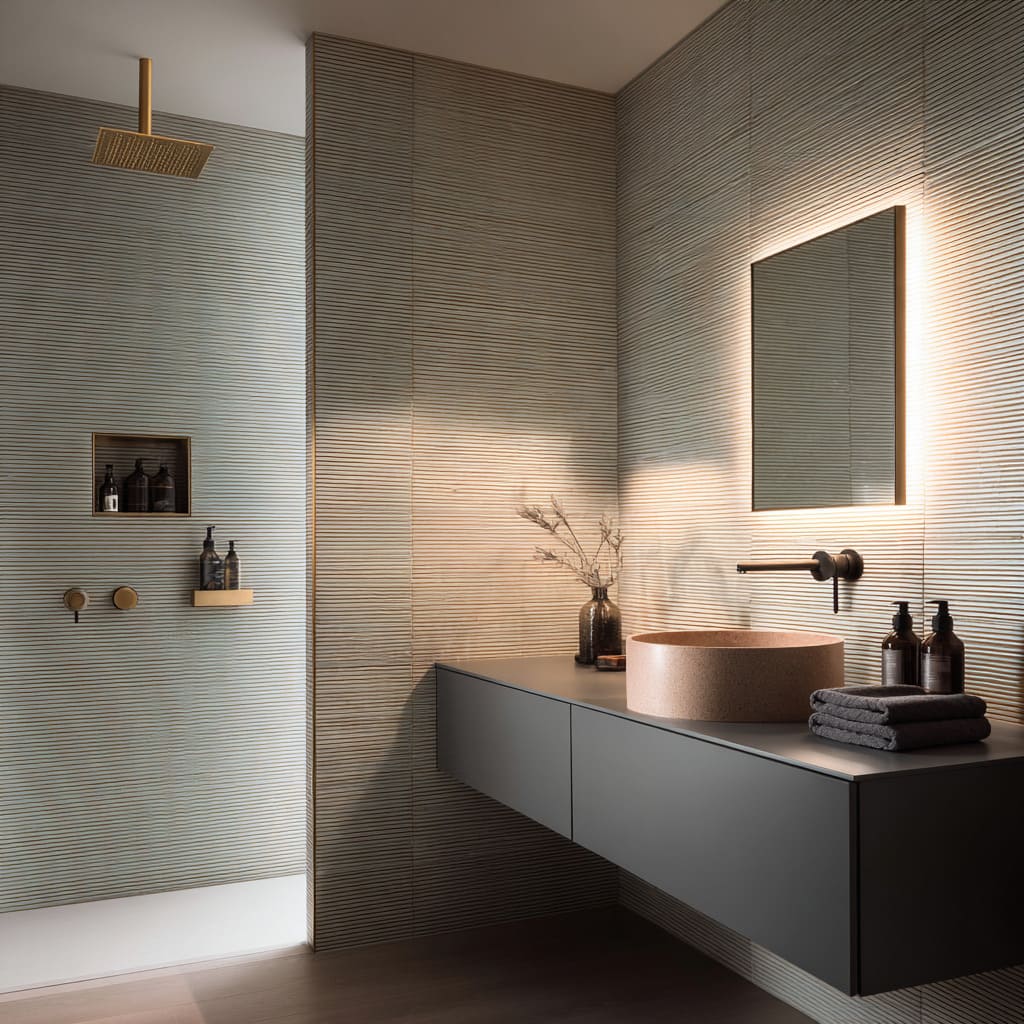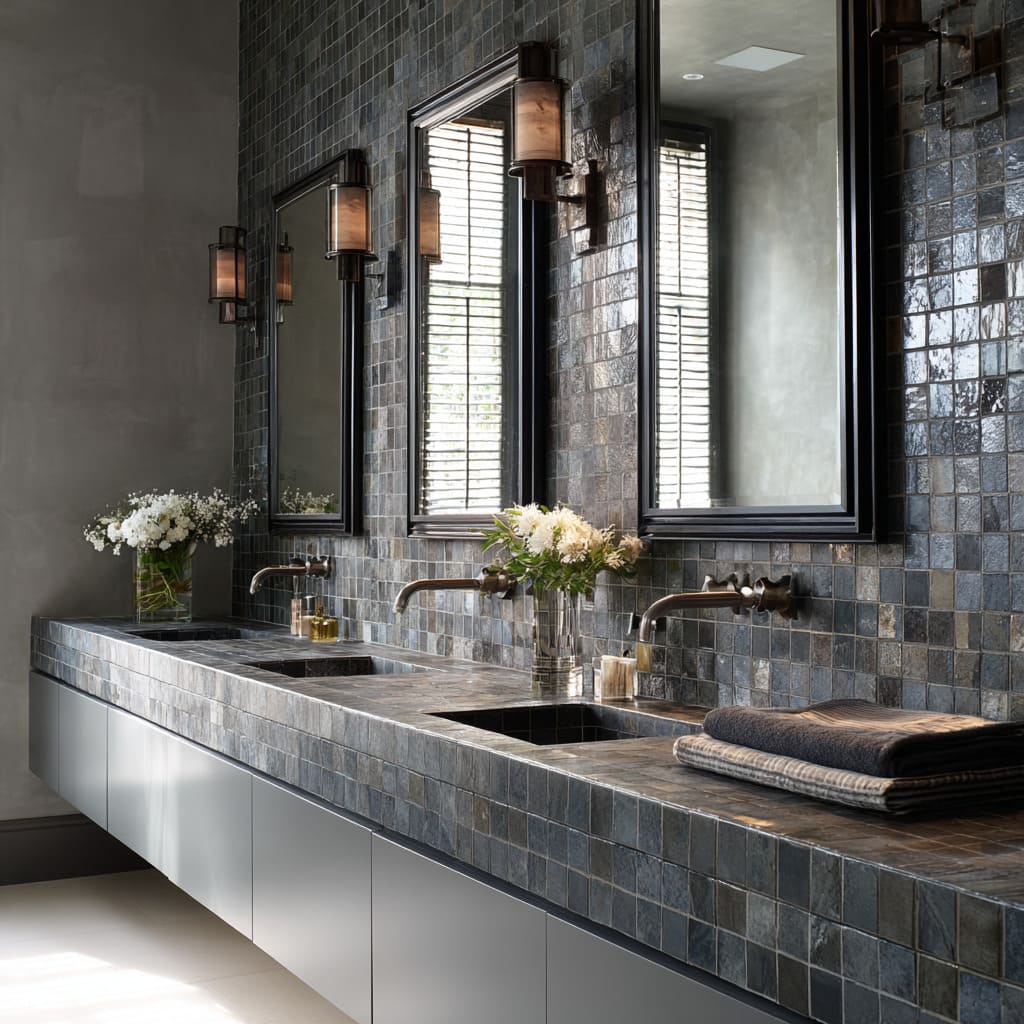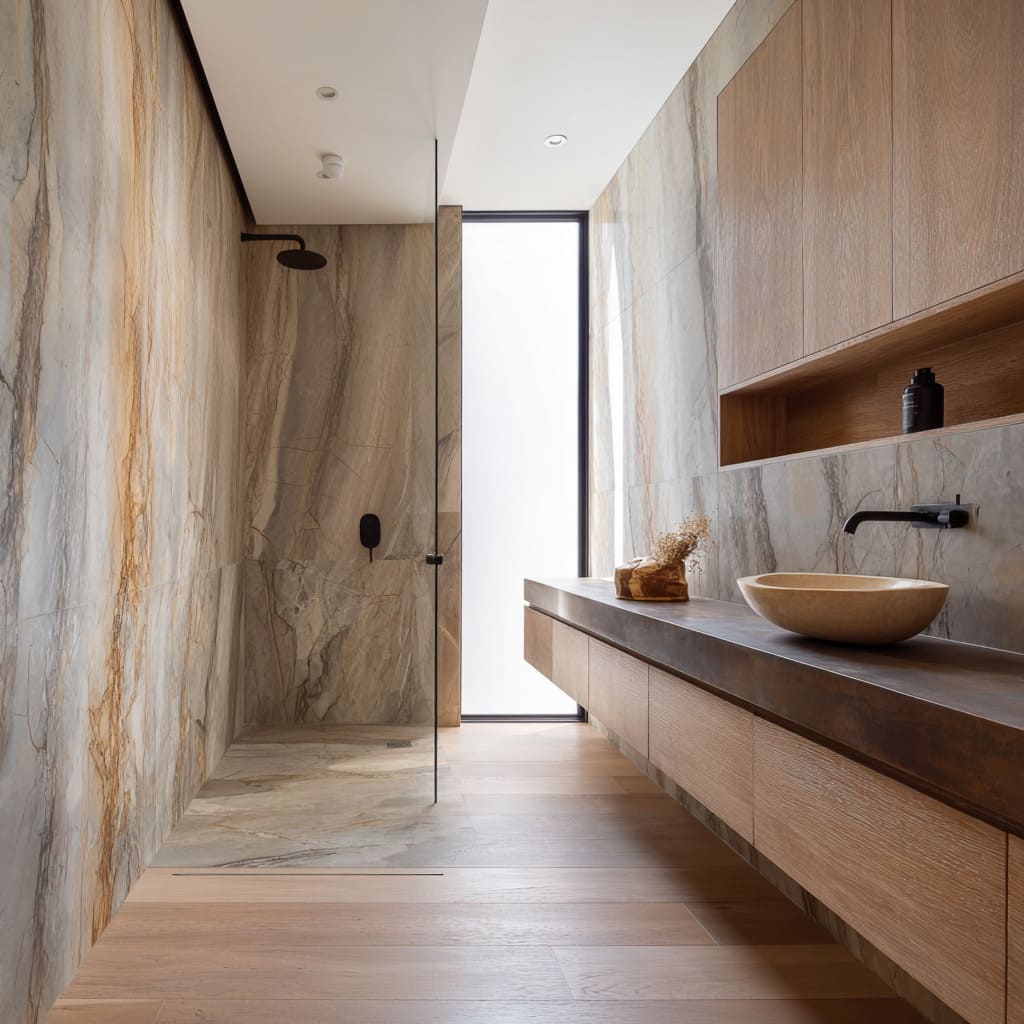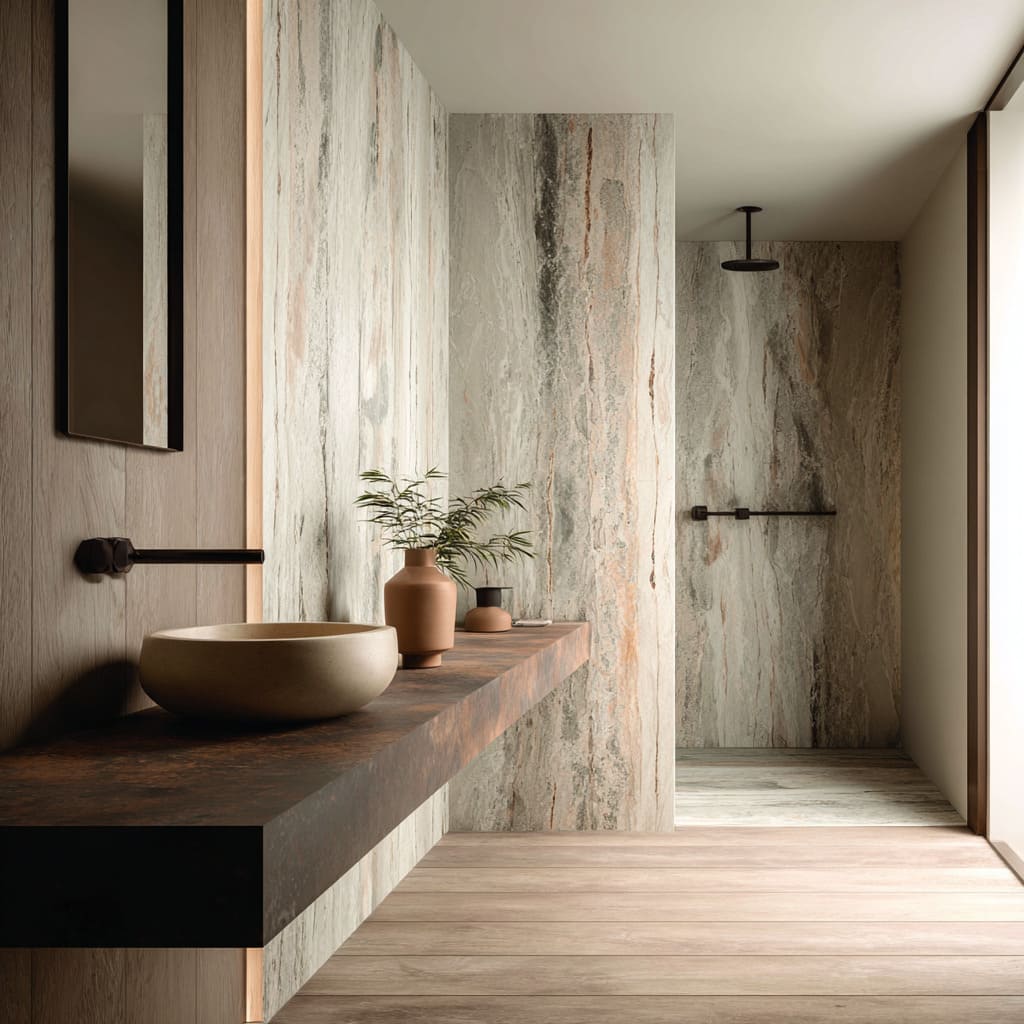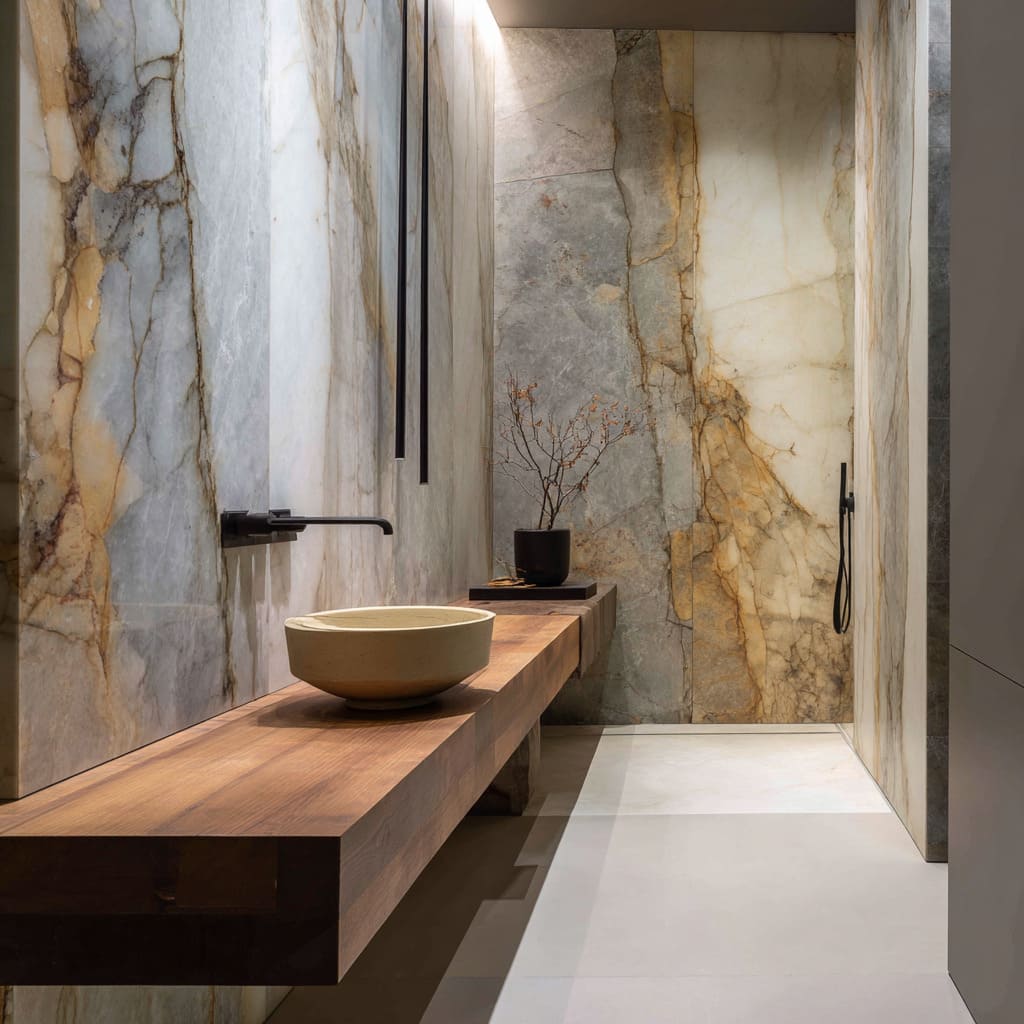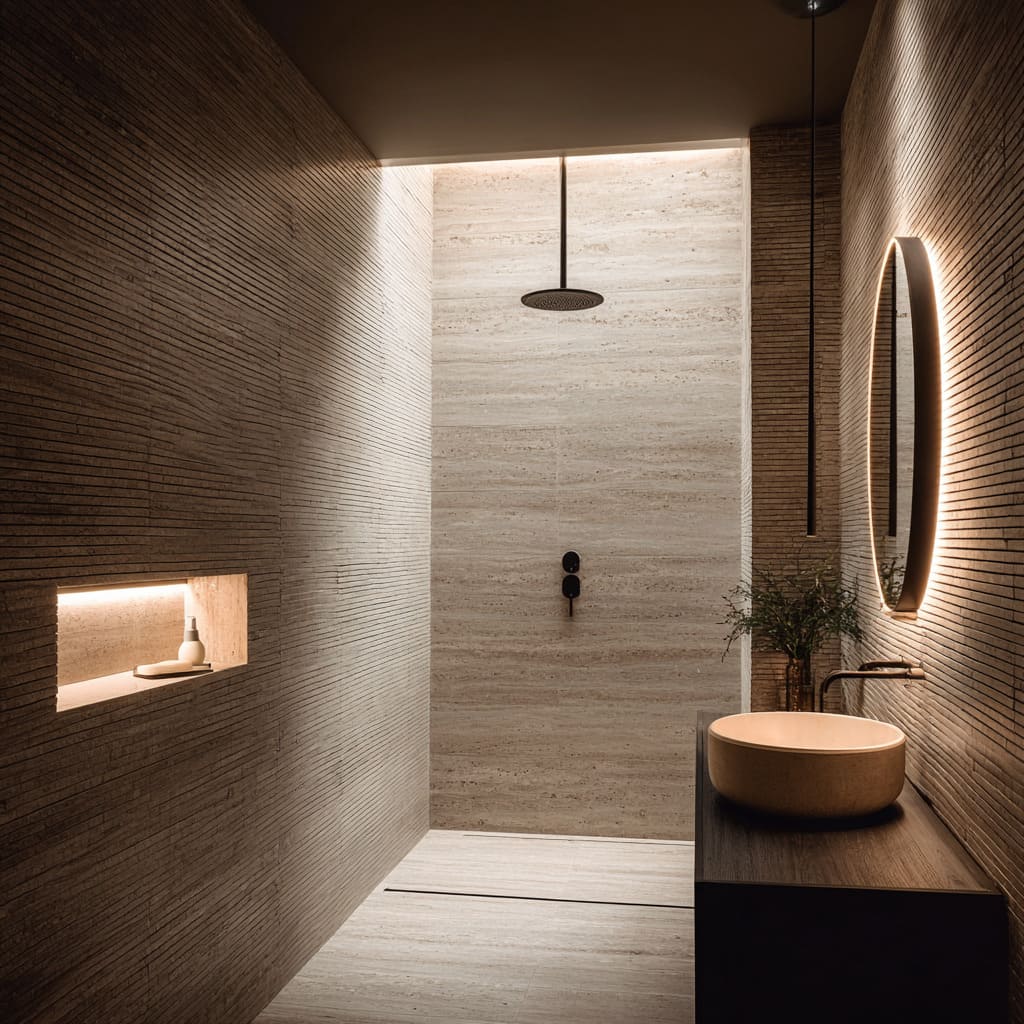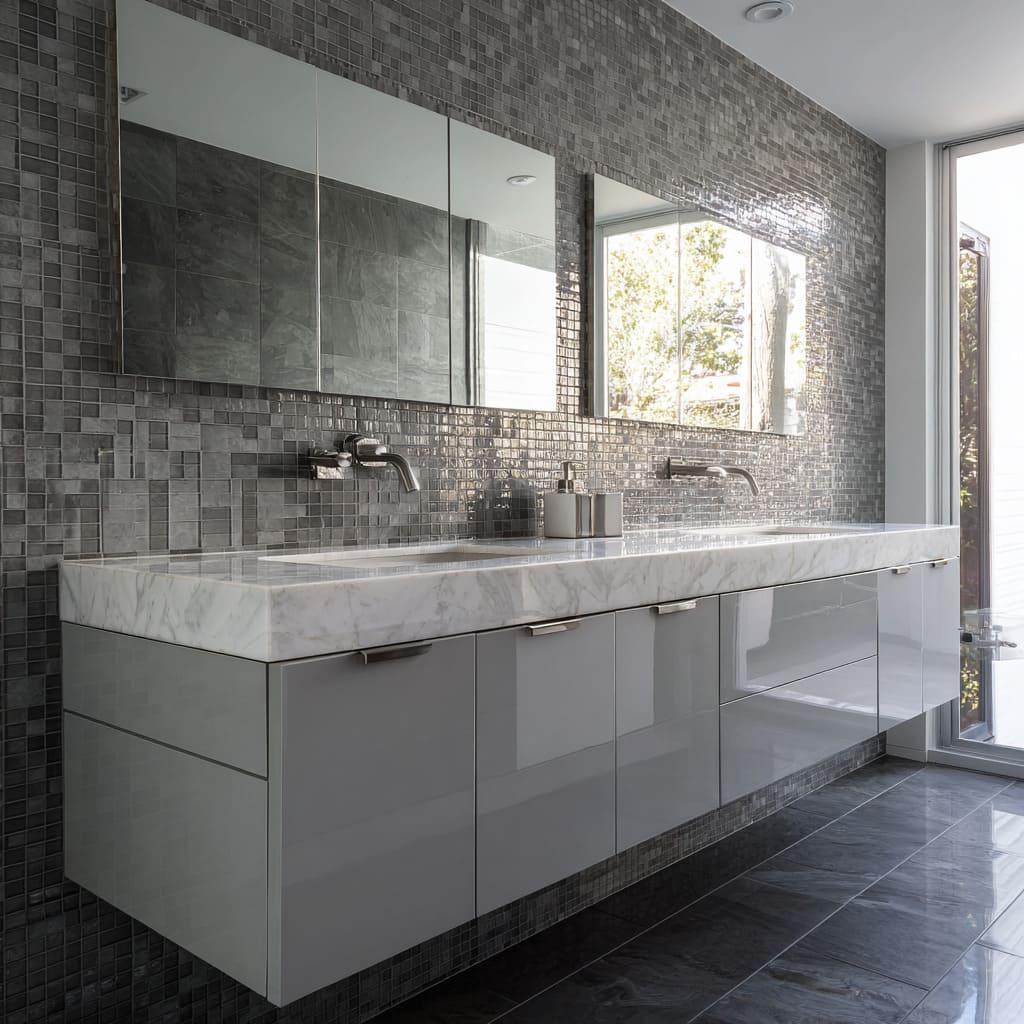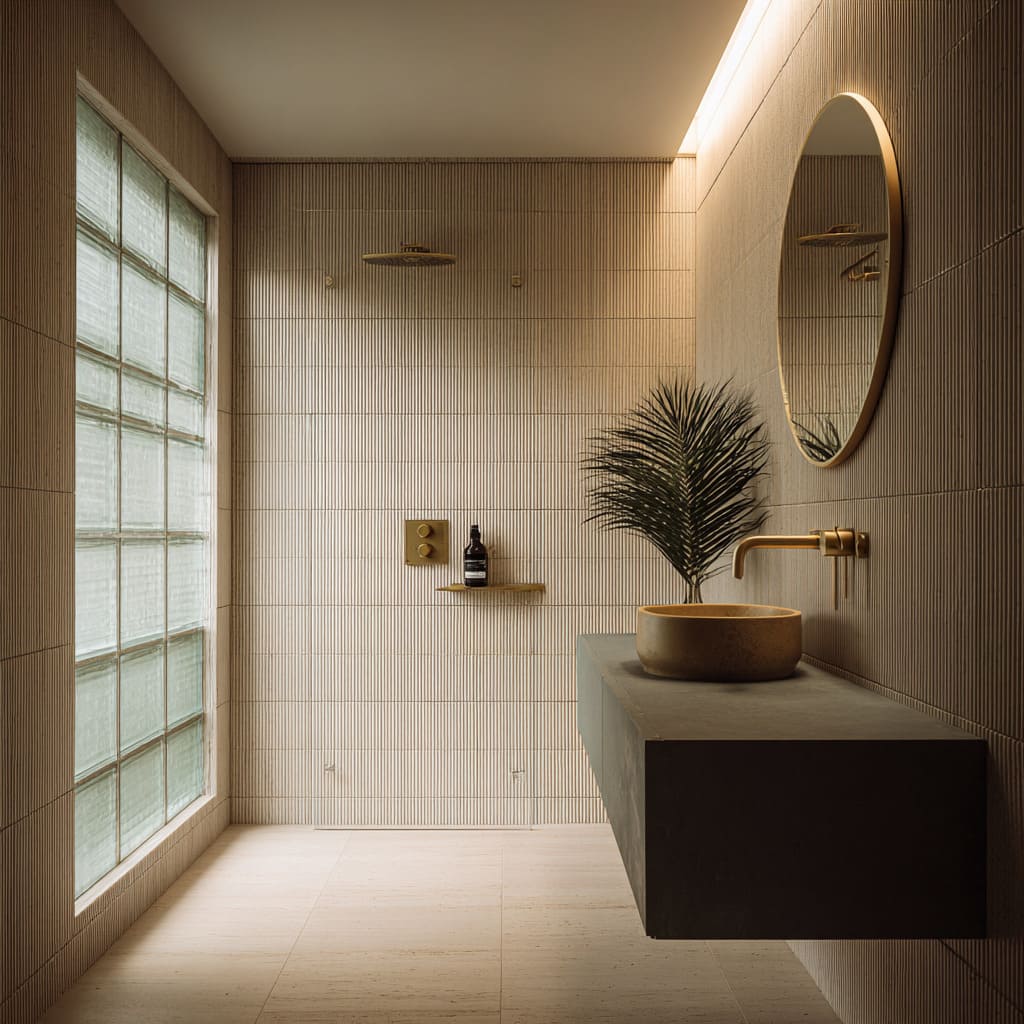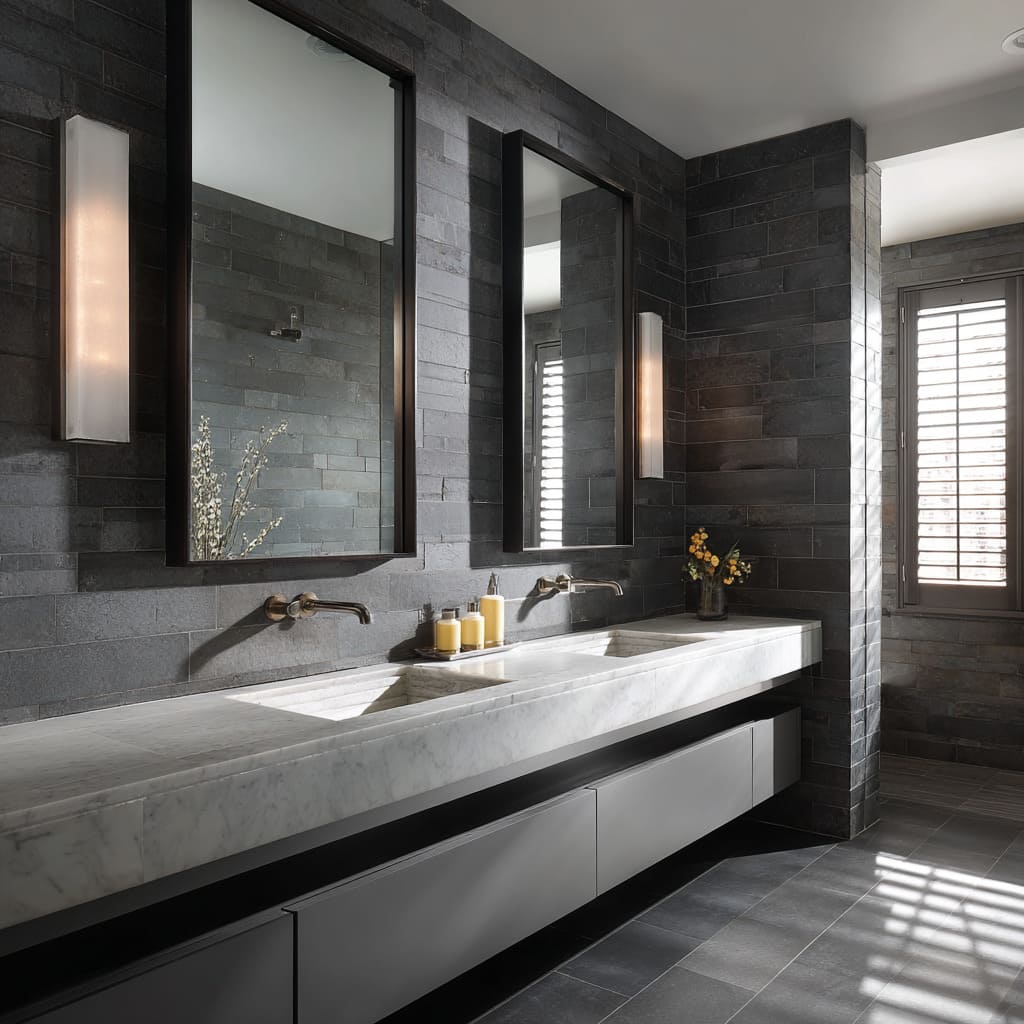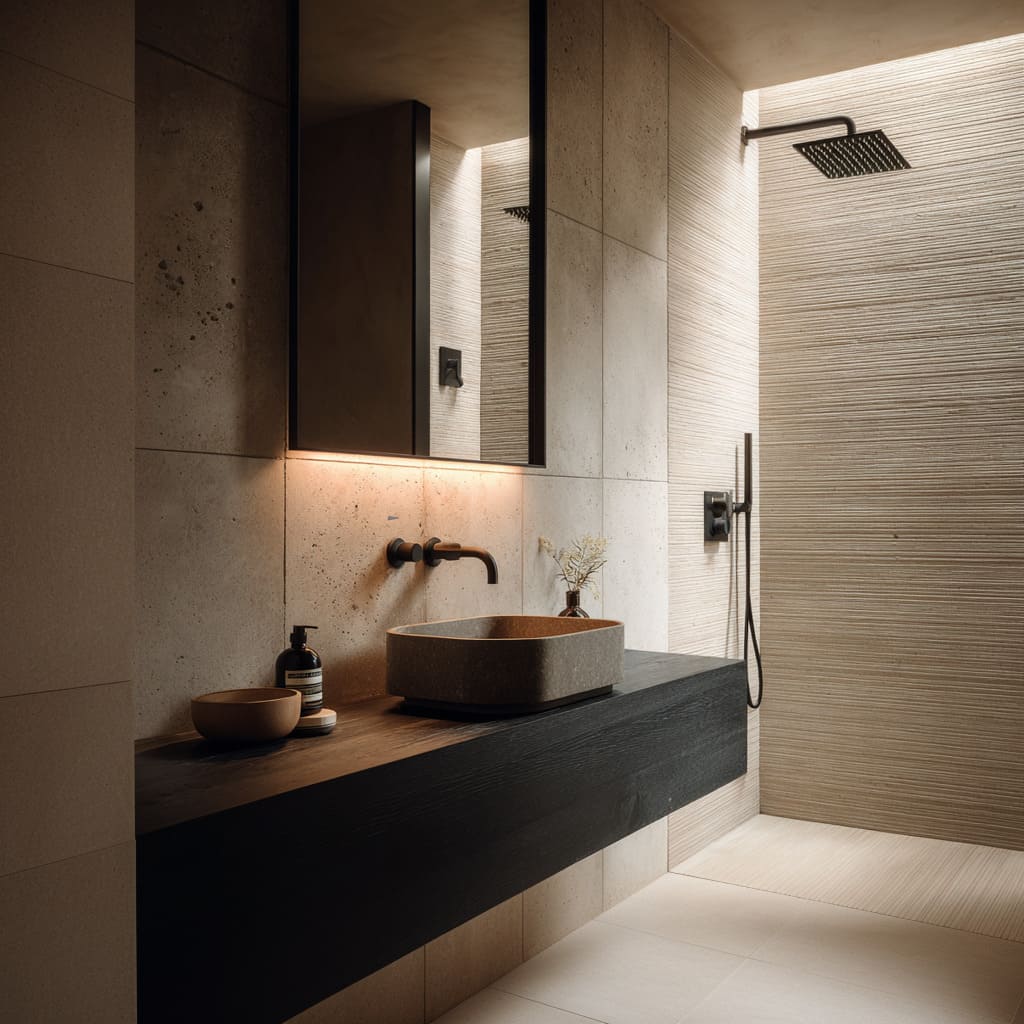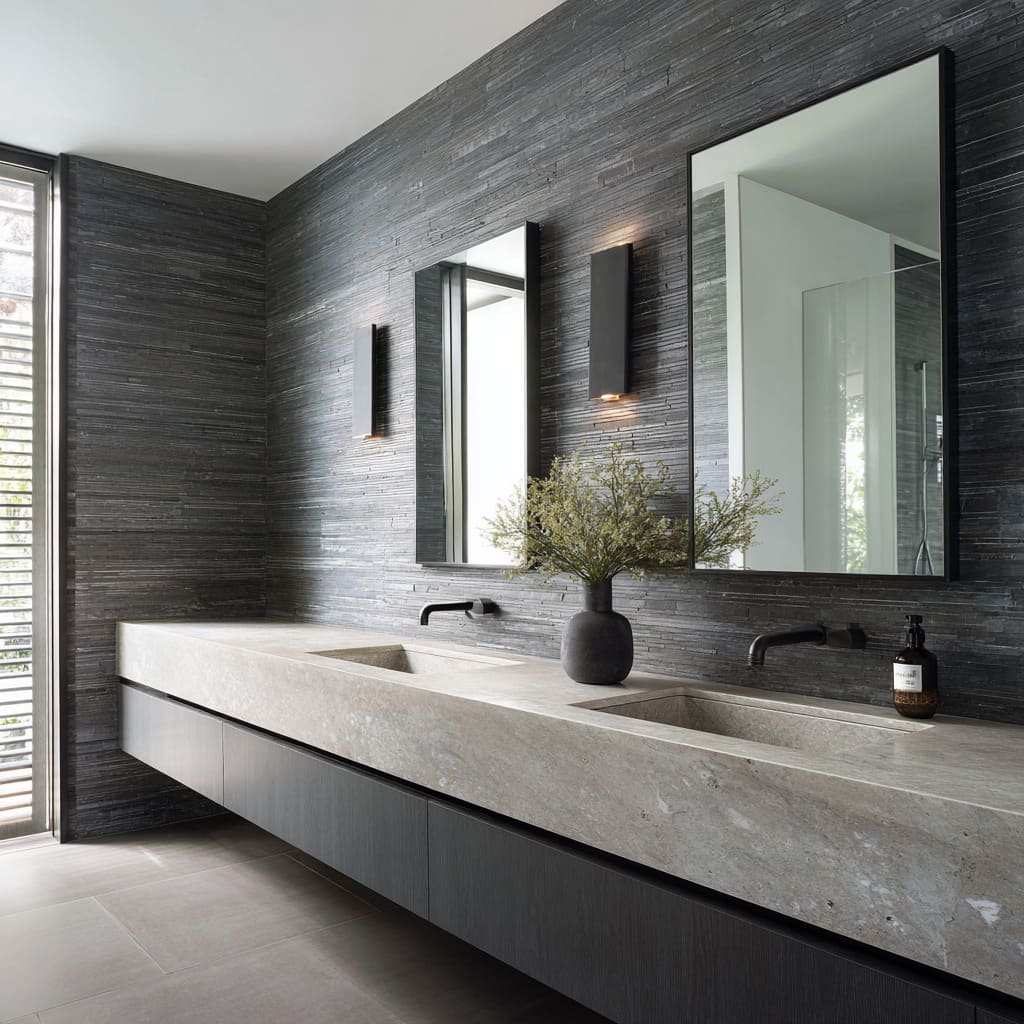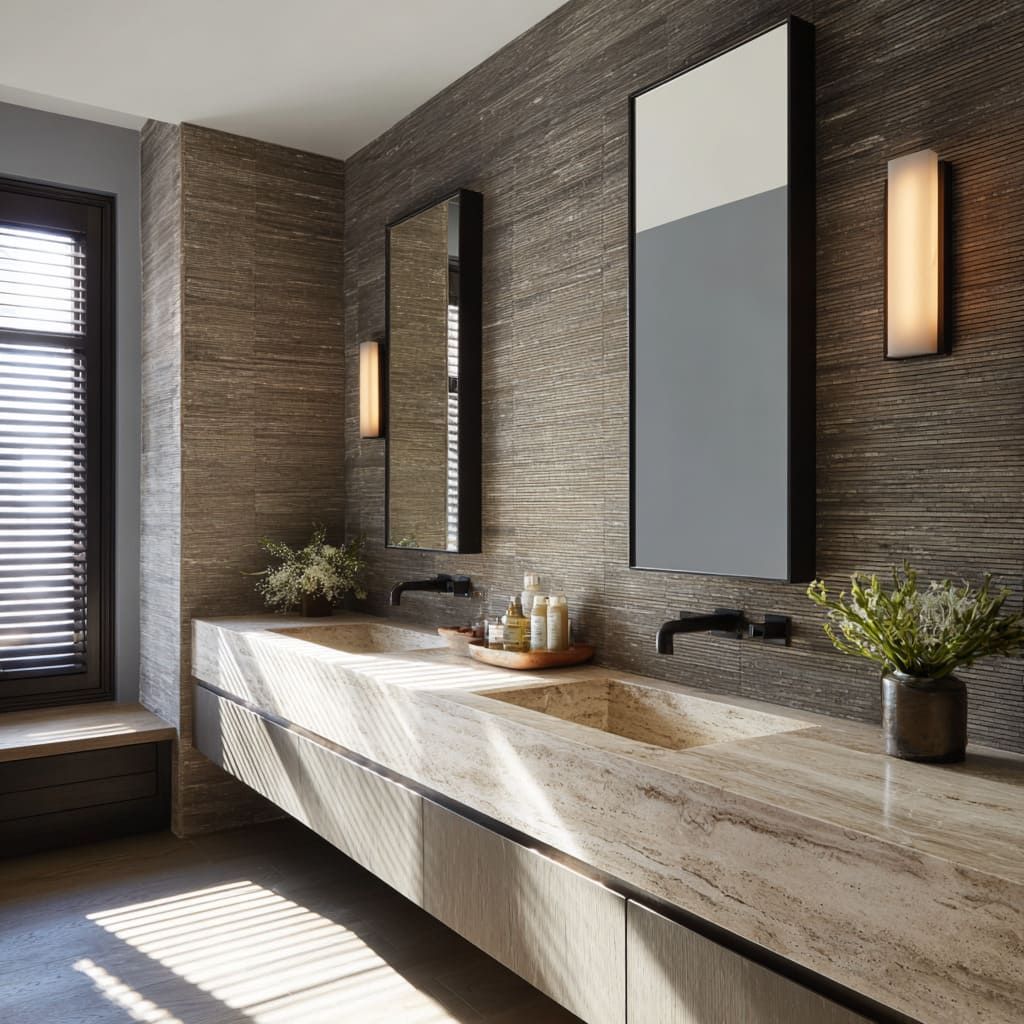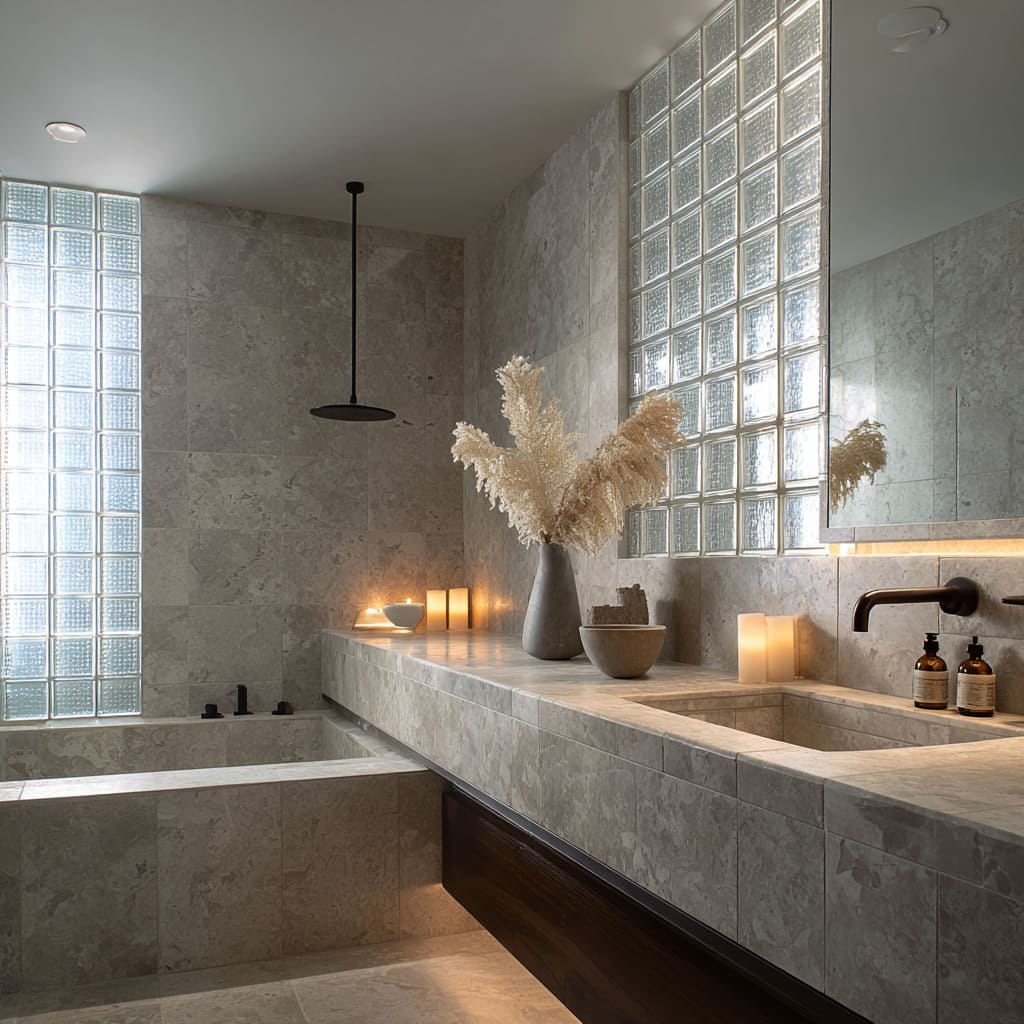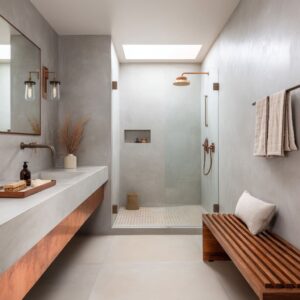Modern bathroom designs increasingly rely on tiles not as fragments of function but as the main visual identity of a room. Instead of thinking in sections, the space is wrapped in one consistent surface language, turning the room into a unified volume rather than a sequence of wet and dry zones.
This approach changes how the eye moves across the space: when walls, floors, and built-ins share a common texture, the room feels carved from a single material block, and the fixtures seem gently inserted rather than attached. In this environment, bathroom wall tiles design becomes a foundation for style, where surfaces behave not as barriers but as a soft envelope.
Horizontal ribbing can elongate a compact room, vertical veins can create a quiet rise that lifts the gaze, and smooth monolithic slabs can form gentle, almost sculptural backgrounds. The idea is less about decoration and more about letting the tile create a calm shell in which all other elements—vanities, mirrors, accessories—sit like curated pieces.
This continuous surface strategy also lets lighting fall across the material in slow gradients, producing atmosphere without relying on strong color contrasts or large fixtures.
Orientation, Scale, and Rhythm: How Lines Quietly Build the Feel of the Room
Line direction is one of the most influential and least discussed forces in bathroom layouts. Horizontal patterns create a steady landscape, making a narrow space feel wider and more peaceful, while vertical patterns deliver an upright tension that can build a quiet sense of height.
This interplay is the foundation for many tiled bathroom ideas, where direction alone becomes a tool to stretch or compress the room visually.
Subtle Spatial Engineering Through Line Direction
- Horizontal ribs: soften side walls, create a textile-like feel, and build a slow, calming rhythm.
- Vertical veins: produce gentle gravity, guide the eye upward, and form a visual “spine” behind mirrors.
- Diagonal or drifting streaks: animate otherwise still walls and reduce symmetry in a controlled way.
Scale as a Spatial Narrative
Large slabs introduce broad movement; small mosaics introduce flicker, density, and depth. Mid-scale strips act as a bridge between the two extremes, allowing designers to create background calm while using small areas—niches, mirror walls, counter backsplashes—to bring concentrated texture.
Together, these scale choices create rooms where rhythm is felt more than seen, and where tiles guide motion in quiet but effective ways.
Texture Changes Instead of Color Changes: Soft Transitions and Invisible Boundaries
One of the most refined design ideas in contemporary interiors is the use of texture shifts rather than color shifts for zoning. Instead of switching from one bold tone to another, the modern approach uses subtle changes in grain or scale to communicate function.
In concepts where bathroom tiles design is central, smooth slabs might define the grooming area, while ribbed strips create gentle movement within the shower. Narrow vertical tiles can make upper walls feel lighter, while broad stone panels keep wet areas calm and grounded.
Why Texture Zoning Feels Natural
- It keeps the eye on overall volume instead of dividing the space into compartments.
- It avoids abrupt transitions, which helps compact layouts feel more integrated.
- It gives different activities—bathing, grooming, washing—a quiet identity without visual noise.
This technique also allows color palettes to remain restrained. Beige stone, sandy travertine, pale greys, and gentle taupes can shift from ribbed to smooth or from honed to brushed without breaking harmony.
In essence, texture becomes the wayfinding system of the room, guiding the body rather than overwhelming the eye.
Tiles and Light as Partners: Controlled Glow, Shadow, and Surface Movement
In many contemporary designs, lighting is chosen not for brightness alone but for how it behaves on tile surfaces. Grazing light remains one of the strongest tools for shaping atmosphere: it moves along ridges, reveals veining, and gives small mosaics a lively shimmer.
This relationship transforms even simple layouts into layered compositions. A ceiling slot can wash down a stone wall so that veins feel like slow brushstrokes; an under-vanity glow can lift a heavy slab until it appears weightless; a niche light can make a single bottle feel curated.
These moves create a gentle choreography: light becomes the narrator and tile becomes the stage.
Different Surface + Light Pairings
- Ribbed tile + overhead wash = soft shadows that glide horizontally.
- Veined slabs + ceiling slots = vertical gradients that read like painted panels.
- Glass blocks + daylight = diffused sparkle that shifts from cool to warm depending on the hour.
- Mosaics + window reflections = broken highlights that mimic woven cloth.
This relationship is why modern tiled bathroom design ideas often feature hidden fixtures, floating vanities, and backlit mirrors: the goal is to create a landscape of slow tonal shifts instead of a room filled with visible hardware.
Material Pairings: Stone, Wood, Metal, and Glass as a Cohesive System
A modern tiled bathroom design rarely uses tile alone. The pairing of stone, timber, metal, and glass shapes the emotional tone of the room.
Soft timber introduces warmth against cool stone; dark metal forms precise accents; glass—especially in block form—creates a luminous filter that moderates the palette. In some concepts, pale stone and washed wood build a morning-light atmosphere; in others, charcoal surfaces and bronzed metal create a wrapped evening mood.
Stone as the Visual Anchor
Large slabs supply structure, mass, and quiet drama. Their veining forms natural artwork, especially when layered with gentle cove light.
Wood as Balance and Softness
Floating drawers or counters in warm timber lighten the shell and introduce touchable texture without breaking the tile dominance.
Metal as the Linework of the Room
Thin spouts, minimal mixers, and slender pendant lights create the graphic strokes that keep soft surfaces from collapsing into uniformity.
Glass as a Light-Shaping Medium
Full walls of glass blocks or tall vertical openings create translucent patterns that change throughout the day.
Together, these materials compose a carefully tuned palette where each element supports the others without stealing attention.
Volume, Mass, and the Illusion of Carved Architecture
One of the most striking aspects of modern tiled bathroom design ideas is the shift from decorative tile layouts toward architectural massing. Instead of thinking in flat surfaces, many interiors now use tile to suggest thickness, heft, and excavation.
Built-in tubs appear carved from large blocks of limestone. Integrated basins look like slots sliced into floating stone beams.
Full-height mirrors hover over stone “spines,” turning the wall behind them into a central feature.
Architectural Concepts That Emerge from Tile Work
- Carved basin blocks: counters that feel excavated rather than installed.
- Stone tunnels: continuous slabs across three planes creating immersive spaces.
- Floating volumes: vanities lifted with shadow lines, giving weightless mass.
- Monolithic benches: long ledges running through the shower and grooming zones.
These moves transform tile from surface decoration into architectural statement. They make rooms feel sculpted rather than assembled, creating the kind of depth one usually finds in boutique retreats or quiet wellness interiors.
Composing the Decorative Layer: Objects, Plants, Textures, and Small Visual Anchors
Even in designs defined by strong material choices, the decorative layer remains essential. Accessories can echo the tones of stone, repeat the shape of tile patterns, or contrast the linear rhythm with softer forms.
How the Decorative Layer Extends the Tile Story
- Plants and branches: create delicate silhouettes that counterbalance strict geometry.
- Clay vessels, stone bowls, and soft jars: repeat the mineral palette while adding gentle curves.
- Lantern-style sconces and smoked glass globes: bring warm light into darker tile environments.
- Candles, folded towels, and trays: create low clusters that help organize long counters.
This layer is never random. It always reflects or contrasts the lines created by the tiles.
Soft greenery offsets horizontal ribs; terracotta echoes warm mineral streaks in veined slabs; dark bottles reinforce the vertical rhythm near mirrors. Even flooring plays a part: wide planks or smooth slabs can introduce a grounding element that anchors the room while allowing a subtle nod to bathroom floor tile ideas.
The decorative story is designed to be quiet but precise, allowing the main materials to remain the lead characters.
Texture as the Emotional Driver of Atmosphere in Modern Bathrooms
Atmosphere is no longer built solely through fixtures and lighting—it emerges directly from tile selection. Smooth slabs in light stone create a gentle calm suited to bright spaces; dark ridged tiles create depth and a soft shadowed setting; mosaics provide sparkle and movement; warm limestone blocks build a courtyard-like retreat.
Emotional Modes Achieved Through Texture
- Bright and weightless: pale ribbing, slim vertical channels, translucent glass blocks.
- Warm and grounded: limestone or travertine with natural pits and clay-toned accessories.
- Dim and intimate: charcoal strips, deep taupe ribs, warm under-cabinet glow.
- Gallery-like: veined stone used as a vertical slab behind the mirror. This textured mood-building aligns directly with new forms of shower tile ideas, where the shower zone becomes more of a sculptural niche than a boxed compartment. Water becomes a temporary pattern layered over tile structures, especially when placed in front of ribbed strips, broad stone planes, or vertical glass-block grids.
The Shower as a Central Composition
In many modern layouts, the shower zone functions as the visual anchor of the room. It’s not just a functional corner but a curated composition where light, tile direction, and fixtures form a central scene.
When exploring shower tile ideas, the most striking concepts involve treating the back wall as a visual plane—sometimes ribbed, sometimes veined, sometimes mosaic—onto which water becomes an additional layer of movement.
The Shower Wall as a Canvas
Ribbed horizontal strips create a calm stage for thin metal lines. Veined slabs turn the shower into a tall natural artwork.
Smooth monochrome surfaces paired with a ceiling wash create a warm glow.
Water as a Temporary Pattern
In designs with long horizontal joints, falling water appears as a vertical counter-pattern. In spaces with vertical veining, water becomes another downward movement, blending with stone streaks to create a layered, almost poetic effect.
Fixtures as Drawn Lines
Minimal stems, slim arms, quiet discs, and soft bronze tones act like graphic strokes against tile. They provide structure without distracting from the material narrative.
This approach leads to shower tile designs that feel less like functional enclosures and more like curated alcoves within a sculptural space.
Conclusion:
Modern tiled bathroom environments show how surface choices now shape the emotional character of a room far more deeply than individual fixtures or decorative accents. Across these concepts, tiles act as the main storytelling medium: they stretch proportions through line direction, soften space through finely tuned textures, and anchor the entire composition through scale and mass.
Lighting becomes an active partner, revealing ridges, streaks, veins, and mosaic glimmer with slow movement, while materials like stone, wood, metal, and glass settle into balanced roles that support the tile narrative. Architectural gestures—carved basins, floating slabs, long benches, continuous walls—rely on tile continuity to maintain the illusion of sculpted volume.
Even the smaller details, such as greenery, clay pieces, or soft jars, function as gentle counterpoints to the stronger architectural language set by the tiles.
Together, these ideas show that modern bathroom design has moved away from patchwork solutions and toward holistic environments where tile is not merely surface coverage but the defining element that organizes rhythm, atmosphere, and visual flow. The room becomes a composed envelope of texture and light, where water, shadow, and subtle material pairings contribute to a layered and calm visual experience.
